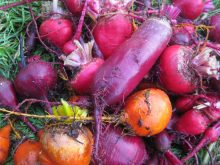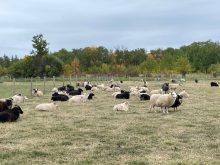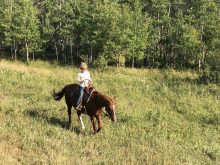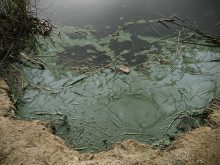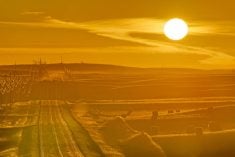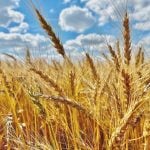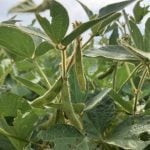Unfortunately, by the time this issue hits your mailbox, many farmers will have the slim pickings of 2023 in the bin or bales. It has been especially brutal for cattle folks who have little hay to bale and face the awful decision of downsizing herds, including the loss of genetics built up over many decades.
In dry spells like this, water well drilling ramps up big time, so I will provide some information that may help with that.
A search for water is a search for sand
Read Also

Claas brings 1000 Series SP forage harvesters to Canada
In mid-August, Claas unveiled its new line of Jaguar forage harvesters at an event in Visalia, California, deep in the heart of that state’s dairy region.
Groundwater is present almost everywhere. A five-inch auger test hole to 50 feet will almost always have water in it — if you leave it long enough to seep into the hole. On July 29, 1998, we augered a 70-foot hole just east of my Quonset at the Dundurn farm. It was dry when completed at 11:15 a.m., but by 4 p.m. that day, water was at 64.7 feet. The final static water level was at 10.2 feet on August 8. There was water, but TDS (total dissolved solids) was 3,800 ppm. And a completed well would’ve had a very low yield and wouldn’t water many cows, and the poor quality would preclude use for stock.
Just across the road from me, a neighbour completed a well in October 2019. There was a thin aquifer (gravel and rocks) at about 50 feet, and it was artesian (non-flowing) with static water level at about five feet. The minerals in the water were only 2,200 ppm — so good for cows. The owner wanted to drill in the adjacent water runway, but the driller said it was too wet to risk a rig, so the owner drilled on the flat above the runway.
In our area of the Allan Hills, most of the water runways have an aquifer beneath and flowing wells are easy to find. A flowing well sounds nice but can be a pain to manage. Best to step up a bit in elevation and get a well, but not have to deal with the year-round flow.
Information about existing and historic water wells
The first step is usually to ask around with neighbours to get an idea of what you are up against. As farms get larger and farther apart that source is diminishing. In remote pasture situations, there might be no nearby neighbour to ask.
However, in many cases, the records of wells long since abandoned are still accessible. In Alberta and Saskatchewan, there is a lot of good information available with a few mouse clicks.
Alberta
Information on Alberta wells is easily available online. You can look up water wells by owner, legal location or by zooming in to where the orange dots show the location of wells. For example, clicking on a dot near Hanna, Alta., brings up the information shown in Figure 1.

Saskatchewan
The Water Security Agency, headquartered in Moose Jaw, has a very good website with much information about groundwater that is easily accessible. Individual well information can be looked up by owner name, legal location and a unique water well driller’s number.
The website presents a provincial map that tells you how to get what you want. As you zoom in, red dots will show the location of wells and clicking on a dot will bring up the well information.

Manitoba
Manitoba has much useful information about groundwater and aquifers available online. Much of it deals with specific, named aquifers such as the Assiniboine Delta aquifer, Oak Lake aquifer, etc. Some Manitoba potato production relies on water from major aquifers. They also have printed groundwater and well reports on the NTS (National Topographic System) on a map sheet basis. The information includes water quality data, so it’s very useful for anyone contemplating a farm well. At the University of Saskatchewan office, I have a large box full of Manitoba water well and aquifer information. But I have not been able to access individual Manitoba domestic well information online. If I am missing something, I am sure readers will enlighten me.
Golden oldies
In 1935, the feds did a comprehensive farm water well survey in southern Saskatchewan and the results were published in a report for each RM the next year. Those with Henry’s Handbook of Soil and Water can check out page 152 for more information. For Saskatchewan, a Google search of “Groundwater Resources of the Rural Municipality of Milden No. 268,” for example, will spit out a complete report and map of that RM. In 1935, there were many more farms than now, so the density of information is great.
However, the surveys did not end in 1935, so information for Manitoba and Alberta is available from later years. The federal government’s website brings up a “Browsing” option with a long list you can look through and you can click on any RM you wish.
That list also includes many provinces, so I use it if I want info for British Columbia, Ontario or the Maritimes. If you scroll down enough, you come across a list of Saskatchewan RMs by number. You can just scroll down to your RM number and click, and, voilà, up pops enough info to keep you busy for a while.
There you have it — some places to look before engaging a driller to dig and complete a well for you. Drillers are also a wealth of information for the areas they have worked in for years. Water well drillers are a unique bunch — much like farmers — fiercely independent, good equipment operators, repair wizards, a good business head and they know how to appreciate good staff.
At times like this, provincial governments often have special programs to assist with finding a water supply for livestock.
If you are in need, I hope you get a good well soon.




